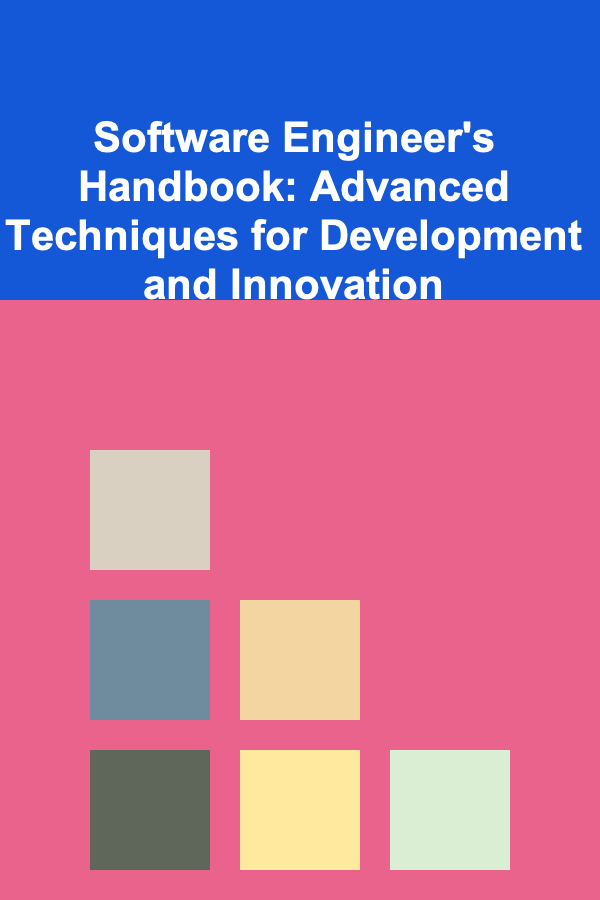
Software Engineer's Handbook: Advanced Techniques for Development and Innovation
ebook include PDF & Audio bundle (Micro Guide)
$12.99$6.99
Limited Time Offer! Order within the next:

Software engineering is a constantly evolving field, where development techniques, tools, and methodologies grow rapidly. The need for innovation, efficiency, and scalability in software design has never been more critical. As developers, our role extends beyond simply writing code---we are tasked with solving complex problems, optimizing performance, ensuring maintainability, and driving innovation in the digital world.
In this handbook, we will explore advanced techniques in software engineering that can help developers move from competent programmers to masters of their craft. The focus will be on strategies that go beyond basic programming skills, providing actionable insights for those who wish to stay ahead in this fast-paced industry.
Mastering Design Patterns for Scalable and Maintainable Architecture
Design patterns are not just theoretical concepts---they are practical tools that can help solve common problems in software development. These patterns are essential for creating scalable and maintainable systems, and mastering them can drastically improve your design and development skills.
Key Patterns to Learn:
- Factory Pattern: The Factory Pattern simplifies object creation by delegating it to a factory class, ensuring that your code is decoupled from specific object creation logic. This is invaluable when dealing with complex object creation, especially in large systems.
- Singleton Pattern: The Singleton Pattern ensures that a class has only one instance and provides a global access point to that instance. It is typically used for managing shared resources, such as database connections or logging services.
- Observer Pattern: When an object's state changes, and you need to notify other objects about the change, the Observer Pattern is ideal. It decouples the components, allowing them to interact without tight dependencies.
- Strategy Pattern: This pattern allows a class to select a particular algorithm or behavior at runtime. It's often used when you have multiple ways of performing an operation and want to make the code more flexible by separating concerns.
How to Apply Design Patterns:
- Understand the Problem: Design patterns are most effective when the problem you're solving fits a known pattern. Recognize the recurring issues you face and choose the appropriate pattern.
- Avoid Overuse: While design patterns provide elegant solutions, don't overuse them. Excessive use of patterns can make your codebase unnecessarily complex. Use them when the problem warrants their application.
- Decouple Code: Design patterns often help decouple components, making the system more modular. This modularity is essential for long-term maintainability and scalability.
Mastering Test-Driven Development (TDD) and Continuous Testing
Test-Driven Development (TDD) is a technique that has become a cornerstone of professional software engineering. The primary goal is to write tests before writing the actual code, ensuring that every component of the system is thoroughly validated.
Why TDD is Essential:
- Reliability: By writing tests first, you ensure that each function or method is tested thoroughly from the outset. This leads to fewer bugs and a more reliable product.
- Refactoring Confidence: TDD gives developers the confidence to refactor code. Since tests are written upfront, any changes or optimizations can be tested immediately to ensure they do not introduce new issues.
- Faster Debugging: With a comprehensive test suite in place, debugging becomes much faster. When a test fails, you know exactly where the problem is, speeding up the debugging process.
The TDD Cycle:
- Write a Test: Start by writing a test for a small unit of functionality. This test will fail initially because the feature has not been implemented yet.
- Write the Code: Next, write just enough code to pass the test. Avoid writing extra logic or code that is not necessary to pass the test.
- Refactor: Once the test passes, refactor the code to make it cleaner, more efficient, or more readable, while ensuring that the test still passes.
Continuous Testing and Integration:
- Automate Tests: Use CI/CD (Continuous Integration/Continuous Deployment) pipelines to automate the running of tests whenever changes are made. This helps to detect issues early in the development process.
- Test Coverage: Aim for high test coverage but avoid the temptation to write tests for everything. Focus on the most critical paths and edge cases, ensuring that your tests are meaningful and effective.
Mastering Concurrent and Parallel Programming
As applications become more complex and the need for high-performance software increases, mastering concurrent and parallel programming has become essential. This skill enables software to perform multiple tasks simultaneously, which is crucial for handling modern workloads, especially in web services, real-time systems, and data processing.
Concurrency vs. Parallelism:
- Concurrency: Concurrency is about managing multiple tasks at once, not necessarily executing them simultaneously. The focus is on managing time slices and ensuring that tasks are handled efficiently in a shared resource environment (e.g., CPU, memory).
- Parallelism: Parallelism, on the other hand, involves performing multiple tasks at the same time, often using multiple processors or cores.
Key Techniques:
- Locks and Mutexes: Locks are fundamental for controlling access to shared resources in a multithreaded environment. They prevent race conditions by ensuring that only one thread can access the resource at a time.
- Message Passing: In some scenarios, message passing is more efficient than shared memory. By passing messages between processes or threads, you can avoid issues related to memory synchronization and locking.
- Async Programming: Asynchronous programming is another powerful technique, allowing programs to handle multiple tasks concurrently without blocking. In languages like JavaScript (Node.js), Python (asyncio), and C# (async/await), asynchronous programming can vastly improve I/O-bound performance.
Best Practices for Concurrent and Parallel Programming:
- Avoid Deadlocks: Deadlocks occur when two or more threads are waiting for each other to release a resource, resulting in a standstill. Use proper locking mechanisms and avoid nested locks when possible.
- Minimize Context Switching: Context switching, when the CPU switches between tasks, can reduce performance. Aim to keep threads busy with meaningful work rather than switching between tasks frequently.
- Use Immutable Objects: Immutable objects cannot be modified after creation, making them a good fit for concurrent environments, as they eliminate the need for locks when reading data.
Leveraging Cloud Technologies and Microservices
With the growing demand for scalable and resilient software, cloud technologies and microservices architectures have become essential for modern software development.
Microservices Architecture:
Microservices architecture involves breaking down an application into small, loosely coupled services, each responsible for a specific business function. This architecture offers several benefits, such as:
- Scalability: Each service can be scaled independently based on demand.
- Resilience: If one service fails, it does not bring down the entire application.
- Faster Development: Different teams can work on different microservices simultaneously, speeding up development.
Cloud Technologies:
Cloud computing provides the resources necessary to build, deploy, and scale applications with ease. It offers benefits like:
- Elastic Scalability: You can scale your applications up or down based on traffic or resource needs.
- Serverless Computing: In serverless architectures, developers focus purely on writing functions without worrying about the underlying infrastructure.
- Containers: Technologies like Docker allow developers to package software into containers that run consistently across different environments.
Implementing Microservices in the Cloud:
- API Gateway: An API Gateway is often used to aggregate requests from clients and route them to the appropriate microservices.
- Service Discovery: In dynamic cloud environments, service discovery is essential for ensuring that microservices can find and communicate with each other.
- Continuous Deployment: Use CI/CD pipelines for continuous integration and deployment of microservices. This ensures that each microservice is tested and deployed independently without affecting the entire system.
Fostering Innovation with Machine Learning and AI
Machine learning and artificial intelligence are no longer buzzwords---they are shaping the future of software development. Integrating AI and ML into applications can provide intelligent features such as recommendation systems, predictive analytics, natural language processing, and autonomous decision-making.
Practical Use Cases:
- Recommendation Systems: Use collaborative filtering and content-based filtering techniques to suggest products, services, or content to users based on their behavior or preferences.
- Natural Language Processing (NLP): NLP allows software to understand and generate human language, enabling features like chatbots, voice assistants, and sentiment analysis.
- Predictive Analytics: Machine learning models can predict future outcomes based on historical data. This is useful in industries like finance, healthcare, and retail.
How to Integrate ML/AI into Your Projects:
- Understand the Problem: Before diving into machine learning, clearly define the problem you are trying to solve. Whether it's classification, regression, or clustering, understand the type of problem and the type of data you are working with.
- Choose the Right Algorithm: There is no one-size-fits-all algorithm. Select algorithms based on the problem type and data available. For instance, decision trees work well for classification tasks, while deep learning models are ideal for complex image or speech recognition tasks.
- Prepare Data: Machine learning models require large volumes of clean and structured data. Use data preprocessing techniques like normalization, feature extraction, and data augmentation to improve the quality of the input data.
Conclusion
The world of software engineering is constantly evolving, and mastering advanced techniques is essential for staying competitive in the field. By focusing on proven design patterns, mastering TDD, delving into concurrency, embracing microservices and cloud technologies, and leveraging machine learning and AI, software engineers can unlock new levels of innovation and performance. These advanced techniques not only improve the quality and efficiency of software but also empower developers to build solutions that are future-proof, scalable, and impactful.

How to Choose Between Saving for Retirement or Paying Off Debt
Read More
How to Get Rid of Mold and Mildew in Your Home
Read More
How to Grow Your YouTube Audience to Increase Your Earnings: An Actionable Guide
Read More
How to Tackle a Deep Cleaning Project in Your Home
Read More
How to Turn Your Closet into a Space-Saving Haven
Read More
How to Use a Financial Planner to Achieve Your Goals
Read MoreOther Products

How to Choose Between Saving for Retirement or Paying Off Debt
Read More
How to Get Rid of Mold and Mildew in Your Home
Read More
How to Grow Your YouTube Audience to Increase Your Earnings: An Actionable Guide
Read More
How to Tackle a Deep Cleaning Project in Your Home
Read More
How to Turn Your Closet into a Space-Saving Haven
Read More